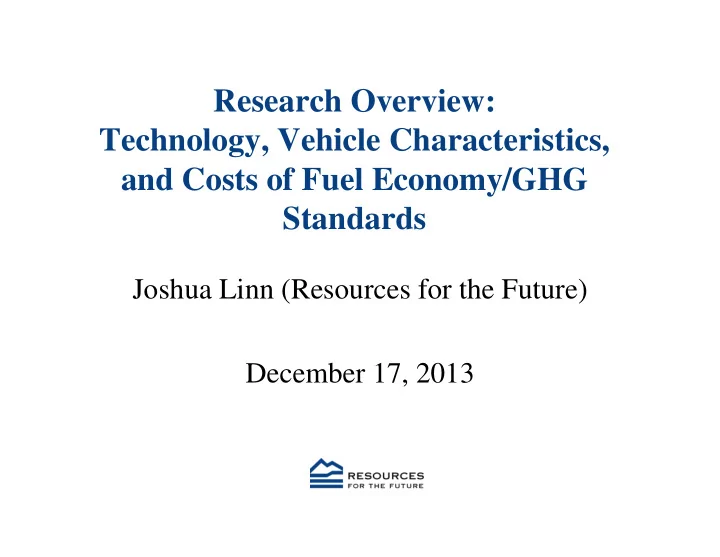

Research Overview: Technology, Vehicle Characteristics, and Costs of Fuel Economy/GHG Standards Joshua Linn (Resources for the Future) December 17, 2013
Recent Research • Passenger vehicle rebound effect � How does fuel economy (as opposed to fuel prices) affect miles traveled? � Using NHTS data, address endogeneity of fuel economy and multi- vehicle households • Effects of tightening standards on vehicle characteristics (with Thomas Klier, Chicago Fed) � Examine recent policy developments in US and Europe � Focus on properly defining the baseline, against which costs and benefits of tighter standards should be measured � How have standards affected: � The rate of technology adoption? � Vehicle characteristics other than fuel economy?
Why We Need to Model Dynamics? • Typical approach (in literature, among regulatory agencies) to estimating costs and benefits of tighter standards: � Begin with an equilibrium prior to tighter standards (e.g., 2011, for the 2016 standards) � Use a computational model to estimate change in fuel economy, vehicle prices, etc., relative to initial equilibrium, such that manufacturers comply • Figure 1 shows steady increases in horsepower and weight from 1985-2005, when standards were essentially constant � The figure suggests manufacturers used power train improvements to increase these characteristics, and would continue to do so in absence of tighter standards • Therefore, the appropriate baseline, from which to measure costs and benefits, is not the equilibrium prior to the tighter standards
Figure 1: Fraction Change in Fuel Economy, Weight and Power, 1975-2008 for Cars Sold by U.S. Manufacturers 0.6 0.5 0.4 0.3 0.2 0.1 0 -0.1 -0.2 -0.3 -0.4 1975 1980 1985 1990 1995 2000 2005 Fuel Economy Weight Power Source: Klier and Linn (2012)
Simple Model to Illustrate the Importance of Dynamics • Manufacturer starts with a particular power train for a given vehicle, and can add technology to improve efficiency • Efficiency fixes location of frontier, which represents combinations of fuel economy and horsepower such that marginal costs are constant • Given the efficiency, manufacturer then chooses fuel economy and horsepower, locating along the frontier (see Figure 2) • Frontier shifts out over time because of innovation and other factors (Figure 3)
Figure 2. Technology Frontier Fuel economy (m) ��� �� Horsepower (h)
Figure 3. Equilibrium Without Tighter Standards Fuel economy (m) X s+1 X s Horsepower (h)
Figure 4. Equilibrium with a Tighter Fuel Economy Standard X* s+1 m* Fuel economy (m) X s+1 X s Horsepower (h)
Implications for Welfare Analysis • Standards cause more efficiency adoption and movement along the frontier (Figure 4) • Consumer welfare improves in absence of tighter standards, and should be baseline against which the effects of standards are measured • Summary � Previous welfare analysis rule out certain manufacturer behavior/responses, such as innovation and shifting along the frontier � This causes welfare cost estimates to be too high � Ignoring technology adoption in absence of tighter standards causes welfare cost estimates to be too low � Which effect is bigger?
Evidence from Recently Tightened Standards • We look at manufacturer behavior in response to four examples of recently tightened standards � US light trucks (2005 and 2011); US cars (2011) � European cars (2007-2009) • Evidence that the standards increased the rate of technology adoption • Evidence the standards reduced US light truck torque (from no-policy case); weaker evidence/smaller effects for US cars and European cars • Comparing observed equilibrium and estimated counterfactual, consumer valuation of lost torque is same order of magnitude as value of fuel savings
Figure 5: Fuel Economy Technology Adoption for U.S. Light Trucks 0.2 0.15 Change in logs since 2000 0.1 0.05 0 2000 2002 2004 2006 2008 2010 2012 -0.05 Frontier Fuel economy Torque Weight
Upcoming Research • Ex post welfare analysis of US light truck standards � Preceding welfare estimates were back-of-envelope calculations, lacking fully dynamic model � Next: estimate fixed costs of vehicle/engine redesign � Challenges to putting together all the pieces: demand estimation, including manufacturer behavioral margins, and cost estimation • R&D expenditure, patenting, and product improvements � Standards, fuel prices, and other factors should affect innovation � Very little research on vehicle innovation, particularly focusing on changes in product attributes as opposed to patents � How do firms make investment decisions? Strategic interactions? � How do consumer preferences and policies affect these decisions?
Other Questions for Discussion • Empirical analysis of technology incentives for fuel prices, standards, fee-bates • Consumer demand for other vehicle characteristics • Uncertainty (regulatory stringency, consumer demand, etc.) • Effects of crediting rules on costs and benefits of standards
Recommend
More recommend